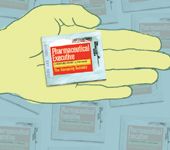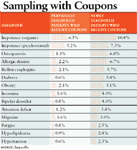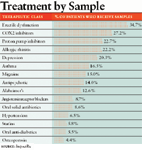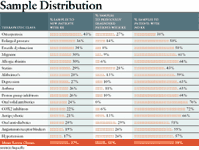The Sampling Subsidy
Pharmaceutical Executive
Physicians give only 25 percent of samples to newly diagnosed patients, along with a prescription.
With a retail value exceeding $10 billion dollars, sampling is a tempting target for industry's cost cutting efforts. The retail value of samples distributed each year to physicians is pharmaceutical companies' second largest promotional expenditure—topped only by the $16.5 billion dollars spent on detailing—yet the effect of this investment on physician prescribing behavior and the market in general is poorly understood.

The relationship between putting samples in a physician's office closet (often shared by several others in a group practice) and changes in patient treatment behavior has been an elusive metric. Because the return on this promotional investment has defied quantification, some pharma management sees reducing samples as a way to improve the bottom line. But those executives are toying with a billion-dollar decision with little or no understanding of the actual role samples currently play in the complicated web of healthcare in the United States.

Sampling with Coupons
ImpactRx has examined this issue since 2001 and has learned some valuable insights. From networks of more than 3,000 high-volume prescribing (HVP) primary care physicians and specialists, the company has collected extensive, longitudinal sample usage data that offers a different look (than has traditionally been available) at the use of samples in our healthcare system.
How Much Subsidy?
With regard to samples, the research has uncovered an intricate relationship between the pharma industry, physicians, and patients. Physicians increasingly view samples as an important subsidy provided by the industry to their patients and thus the healthcare system of the United States. Almost universally, physicians in focus groups emphasize the important role samples play in providing drug therapy to their patients who do not have prescription coverage.

Treatment by Sample
A subset of physicians even refuses to give samples to patients with prescription drug coverage, preferring to save those samples for patients without it. Physicians also express a high degree of gratitude to the industry for providing their patients with samples and feel a need to support the companies that provide this subsidy.
Thus, the United States currently has in place a promotional mechanism in which a substantial portion of the samples distributed by the pharma industry is actually used to subsidize an underground network of support that provides prescriptions to a segment of the population that otherwise would not receive treatment. How extensive is this level of support?

Pharmaceutical Executive
That depends on the therapeutic category. For erectile dysfunction, 34.7 percent of patients receive sample-only therapy. In other words, these patients see a physician and are given samples but not a prescription. In other classes, such as statins for cholesterol and oral anti-diabetics, the percentage is much lower, 5.8 and 5.5, percent respectively. (See "Treatment by Sample.")
Although it is possible to quantify the amount of free therapy given out by physicians, uncovering their motivations is tougher. There are several reasons why a doctor might give a patient samples without a prescription—such as for an initial trial of efficacy and tolerability or simply to make room in the sample closet. Nevertheless, even if just a faction of these sample-only therapies represents physicians purposely providing free treatment to patients who do not have prescription coverage then the industry is contributing a major, virtually unheralded subsidy to the healthcare system of the United States.

Sample Distribution
This has important implications for companies considering making changes to their current sampling system. Samples represent a "safety valve" for physicians by providing a way to treat patients who otherwise couldn't afford medication. Putting an end to sampling could erode, perhaps even destroy, the goodwill accrued by the pharma industry with physicians for providing this subsidy. On the other hand, the industry is currently getting little or no public credit for this enormous subsidy.
Where is the ROI?
Yet industry must still consider how much sampling should be reduced to maximize it return on investment and improve the bottom line. The first step is to look at where samples go after the sales representative puts them in the closet. Physician distribution of samples to patients can be organized into one of three major groups:
1) Samples given to newly diagnosed patients with a prescription
2) Samples given to previously diagnosed patients with a prescription
3) Samples given to patients with no prescription
ImpactRx data collected during the first six months of 2004 reveals some interesting patterns. (See "Sample Distribution,") The most striking finding is that roughly 60 percent of all samples are dispensed without an accompanying prescription—clear evidence of the magnitude of the subsidy provided by the pharma industry. But even stronger evidence can be found with a close examination of the level of samples being dispensed to previously diagnosed patients who also receive a renewal prescription.
Although the average across all therapeutic classes in that group is 15 percent, the highest percentages are found in the chronic conditions: diabetes, high-cholesterol (statins), osteoporosis, and hypertension. These classes constitute an average 27.5 percent of all samples being distributed to previously diagnosed patients.
The data does not distinguish between how much of this behavior is a function of physicians "clearing out their closets" as a result of over sampling and how much is physicians augmenting lack of, or poor, prescription coverage. Yet the information gathered in physician focus groups provides strong anecdotal evidence that a large portion of these samples is given to patients to subsidize their drug therapy.
Also noteworthy is the distribution patterns in the more acute classes. Approximately three-quarters of the oral solid antibiotics and COX-2 samples are distributed to patients without a prescription. Other classes such as proton pump inhibitors (PPIs), asthma, and allergic rhinitis approach the two-thirds threshold. Not all of these samples are given strictly to augment holes in prescription coverage. At least 25 percent of all Americans have no prescription coverage, as reported by National Conference State Legislatures. Some is simply the cannibalization of potential prescription drug customers.
That leaves only 25 percent of samples to be given to newly diagnosed patients with a prescription—the classic scenario of new-patient trial that represents the highest potential return on investment. And any new system that will reduce the tendencies or incentives for physicians to dispense free therapy when the patient could afford a prescription represents a double return for the industry: a paid prescription and no samples dispensed.
What Next?
Because the returns associated with sampling are so poorly understood, analyzing the short and long-term effects of changes in the sample distribution system is challenging. There are hundreds of possible variants between the current status quo and a complete end to sampling. Yet one thing is clear: The ROI of the current system is so low that any attempt to change it is worthwhile.
The easiest solution—a total cessation of sampling—comes with the unacceptable risk of destroying the goodwill accrued with physicians and exposing the industry to increased governmental intervention. So modifying the current system seems more advisable. One viable alternative is to highlight the untapped benefits associated with bringing this hidden subsidy to light. Media coverage of the pharma industry focuses on rising prices, shrinking Rx coverage, and cheaper prices in Canada and Europe. Yet it goes unmentioned that a multibillion-dollar subsidy, financed exclusively by the pharma industry, is in place and growing.
So a case can be made that in configuring a new sample distribution system that quantifies, and perhaps even increases, the use of samples as a healthcare subsidy will generate public goodwill and potentially reduce the call for government controls.
Ultimately however, a more comprehensive revamping of the system needs to occur. What type of system could do this? The first step is to understand and quantify what physicians are giving to patients on a brand-by-brand basis versus just knowing what reps are leaving in the sample closet. These types of data are available and can be used to benchmark brands' performance against one another and quantify the sample ROI. Redeemable vouchers, distributed by physicians and redeemed at pharmacies, might address this issue. The vouchers could be designed with a "check box" specifically asking for the reason the patient was given samples. "Lack of prescription coverage" as one option to check will generate data that should shed light on the true value of this underground subsidy.
Any system that drives patients to the pharmacy will likely have other benefits as well. Roughly 40 percent of samples are dispensed with a prescription, but how many of those prescriptions are actually filled by the patient? Getting patients into a pharmacy to redeem their voucher has the potential to increase fulfillment rates.
Vouchers can also help mitigate another problem: samples that end up in the dumpster. ImpactRx does not collect data on samples that are thrown away because they have expired, but anecdotal accounts from physicians indicate that a significant quantity of samples are ultimately discarded.
This is not unexpected. Physicians are trained to diagnose and treat illnesses, and sales reps are trained to market and sell prescription drug products. But neither is trained in the nuances of inventory management. The current system cannot help but be inefficient. However, this is a real strength of pharmacies. Moving at least some sample distribution to pharmacies will take advantage of the efficiencies inherent in the electronic inventory, billing, and reporting infrastructures that already exist at pharmacies today.
Worth the Effort
Implementing this will not be easy. Any system that has grown to $10 billion dollars in size will prove resistant to change. One of the first problems will be to herd all the major pharmceutical companies toward accepting a new sampling approach at roughly the same time. No one will want to unilaterally change first and expose their products to a potential competitive disadvantage by not having samples in the closet while competitors continue to stack the shelves.
Nor will all pharma companies likely agree on how a replacement system should be designed. The data shows wide differences in sample usage across therapeutic classes, product lifecycles, and even within companies. There will be winners and losers with any change.
These problems, however, are not insurmountable. The current system's ROI is so poorly understood that perhaps some forward-thinking companies will be willing to walk away from it in exchange for a new system with well-defined benefits. The companies that undertake this journey first will also benefit from having the most influence in shaping the new sampling paradigm.
It should also be noted that the industry has already started build the foundation for transitioning from the sample closet to the pharmacy. The use of coupons continues to increase, and physician behavior is adapting accordingly. In 2004, in some categories, 10 percent of newly diagnosed patients received coupons. (See "Sampling with Coupons,") Overall a significant number of patients and physicians have been prepped for change.
Although changing the current sampling system will be painful and messy, it is necessary. The level of inefficiency, waste, and unrecognized value in today's sample distribution makes it worth the effort. The pharmaceutical industry is at one of those rare conjunctions in business where everyone involved—the company, the physician, other healthcare providers, the patient, the pharmacy, and even the government—could all benefit from a new and improved way of doing things.
Nancy Lurker is president and CEO of ImpactRx and can be reached at nlurker@impactrx.com. Bob Caprara Bob Caprara is the company's senior vice-president, advanced analytics and market research, and can be reached at bcaprara@impactrx.com.
The Misinformation Maze: Navigating Public Health in the Digital Age
March 11th 2025Jennifer Butler, chief commercial officer of Pleio, discusses misinformation's threat to public health, where patients are turning for trustworthy health information, the industry's pivot to peer-to-patient strategies to educate patients, and more.
Navigating Distrust: Pharma in the Age of Social Media
February 18th 2025Ian Baer, Founder and CEO of Sooth, discusses how the growing distrust in social media will impact industry marketing strategies and the relationships between pharmaceutical companies and the patients they aim to serve. He also explains dark social, how to combat misinformation, closing the trust gap, and more.
